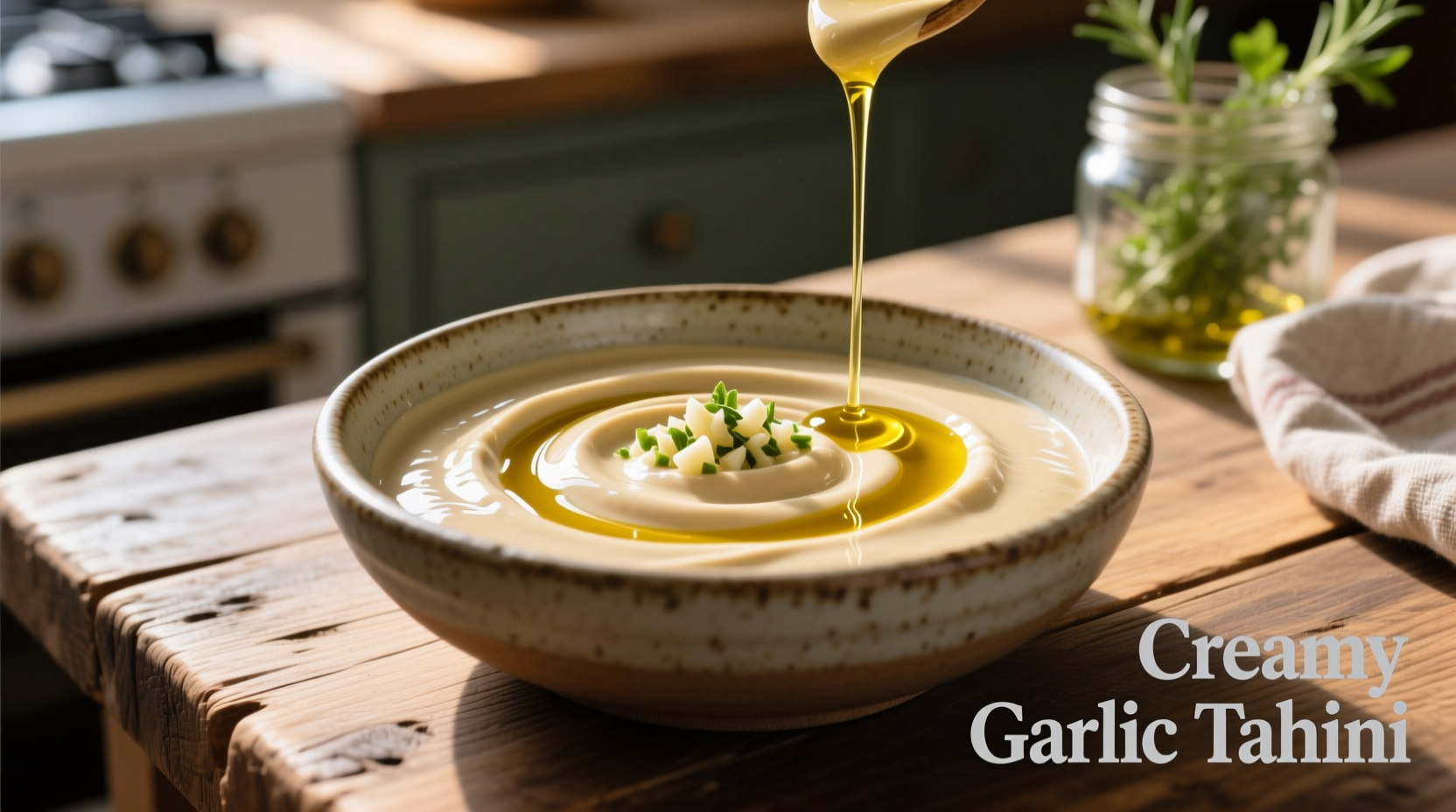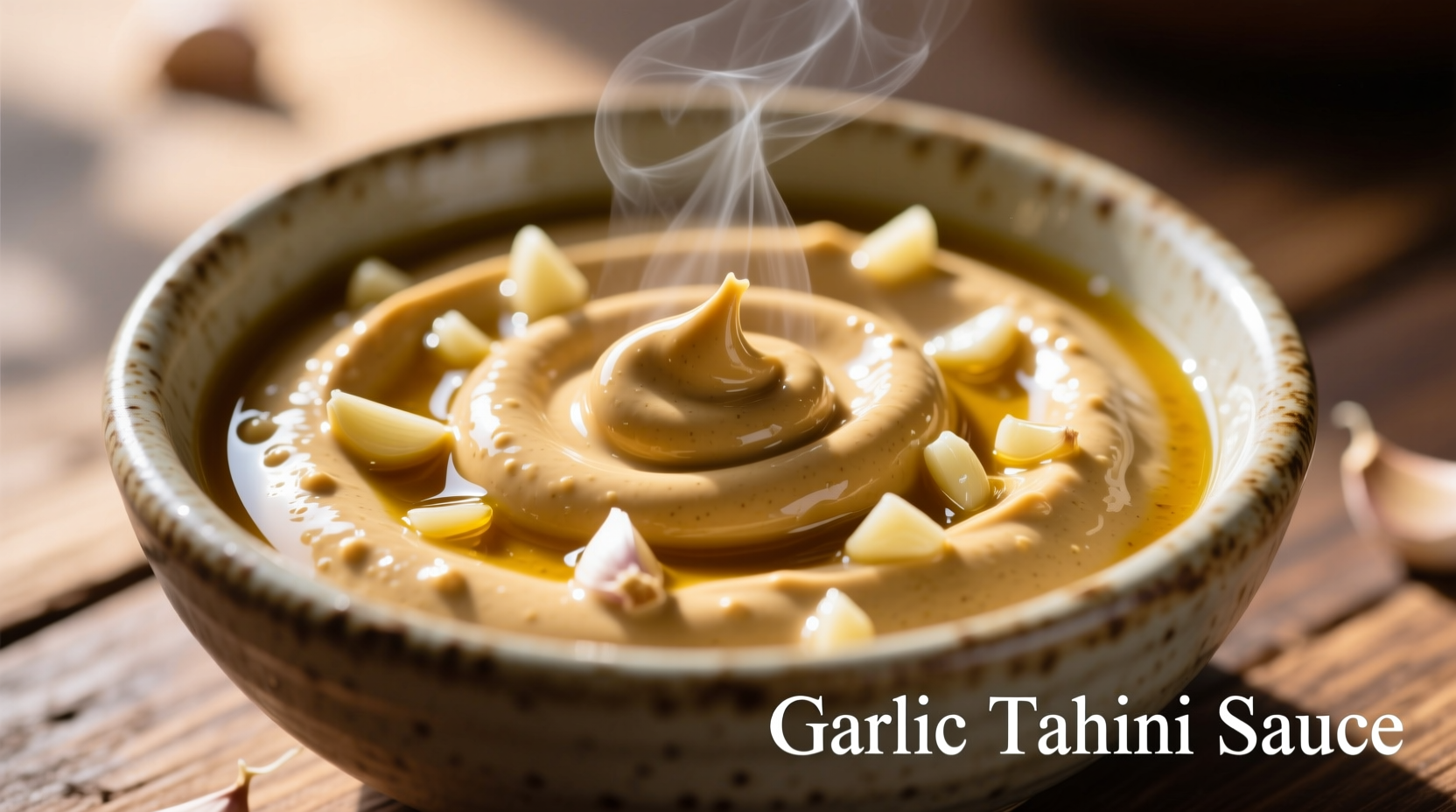Garlic tahini sauce is a creamy Middle Eastern condiment made from blended tahini paste, fresh garlic, lemon juice, and water. This versatile sauce delivers rich nutty flavors with a perfect balance of tanginess and garlic punch, requiring just 5 minutes to prepare with pantry staples. Discover how to make authentic garlic tahini sauce that elevates grilled meats, roasted vegetables, and sandwiches while providing essential nutrients from sesame seeds.
The Essential Guide to Perfect Garlic Tahini Sauce
When you blend smooth tahini paste with freshly minced garlic, lemon juice, and a touch of water, magic happens. This ancient Middle Eastern creation transforms simple ingredients into a creamy, versatile sauce that's become a global kitchen staple. Unlike store-bought versions loaded with preservatives, homemade garlic tahini sauce offers superior flavor and texture control while delivering the nutritional benefits of raw sesame seeds.
From Ancient Staple to Modern Pantry Essential
Tahini's story begins over 4,000 years ago in Mesopotamia, where sesame seeds were first pressed into paste. Historical records from Babylonian tablets mention arḍušu, an early form of tahini used in religious ceremonies and daily meals. The addition of garlic created what we now know as garlic tahini sauce, a preparation method documented in 13th century Egyptian cookbooks.
| Historical Period | Key Development | Cultural Significance |
|---|---|---|
| 2000 BCE | First sesame oil extraction in Mesopotamia | Used in religious offerings and medicinal preparations |
| 1200 CE | Garlic incorporated into tahini preparations | Documented in Egyptian culinary manuscripts as digestive aid |
| 1940s | Commercial tahini production begins in Israel | Post-war food innovation using local sesame crops |
| 2010s | Global popularity surge in Western kitchens | Recognized as versatile plant-based alternative to dairy sauces |
According to culinary historian Claudia Roden's research documented in The Book of Jewish Food, garlic tahini sauce became particularly prominent in Palestinian and Lebanese cuisine during the Ottoman period, where it served as both a nutritious staple and flavor enhancer for modest meals.
Creating Authentic Garlic Tahini Sauce: Step-by-Step
The perfect garlic tahini sauce balances four essential elements: tahini quality, garlic freshness, lemon acidity, and proper emulsification. Follow this professional technique for restaurant-quality results every time.
What You'll Need
- 1 cup (280g) high-quality tahini paste (look for 100% sesame seeds)
- 3-4 fresh garlic cloves, minced
- 1/4 cup (60ml) fresh lemon juice (about 2 lemons)
- 1/4 cup (60ml) ice-cold water plus more as needed
- 1/2 teaspoon sea salt
- Optional: 1/4 teaspoon ground cumin for authentic Middle Eastern flavor

The Professional Method
- Emulsify the base: In a food processor, combine tahini and lemon juice. Process for 1 minute until the mixture becomes thick and pale, almost like whipped cream. This critical step creates the emulsion foundation.
- Add garlic gradually: With the processor running, slowly add minced garlic. Process for 30 seconds to distribute flavor evenly without overpowering bitterness.
- Incorporate water slowly: While processing, gradually add ice-cold water in 2-tablespoon increments. The sauce should transform from thick paste to smooth, pourable consistency.
- Season and rest: Add salt and optional cumin. Transfer to a container and refrigerate for at least 30 minutes to allow flavors to meld. Properly made sauce will thicken slightly when chilled.
Mastering Variations for Different Culinary Applications
Not all garlic tahini sauce applications require the same consistency or flavor profile. Understanding these variations ensures perfect results for every dish.
| Variation | Best For | Modification | When to Avoid |
|---|---|---|---|
| Classic Creamy | Dipping, salad dressing, sandwich spread | Standard recipe with 1:1 tahini to liquid ratio | When a light drizzle is needed |
| Extra-Thin Drizzle | Bowls, grain salads, roasted vegetables | Add 2-3 extra tablespoons water | As a dip or sandwich spread |
| Roasted Garlic | Milder applications, children's meals | Substitute raw garlic with 6 cloves roasted garlic | When sharp garlic flavor is desired |
| Herb-Infused | Fresh vegetable platters, fish dishes | Add 2 tbsp chopped parsley or dill | Traditional Middle Eastern applications |
Food science explains why these variations work: tahini's high fat content (approximately 55% according to USDA FoodData Central) creates different viscosity levels based on water content. The emulsion stability depends on maintaining the proper oil-to-water ratio, typically between 2:1 and 3:1 for optimal texture.
Practical Applications: Beyond the Obvious
While many know garlic tahini sauce as a hummus companion or falafel topping, its culinary applications extend far beyond traditional Middle Eastern dishes. Professional chefs leverage its versatility across multiple cuisines.
Unexpected Pairings That Shine
- Breakfast boost: Swirl into scrambled eggs or use as a bagel spread instead of cream cheese
- Protein partner: Marinate chicken breasts for 2 hours before grilling (the enzymes in garlic tenderize meat)
- Vegetable transformer: Toss with roasted broccoli or asparagus during the last 5 minutes of cooking
- Salad secret: Replace half the oil in vinaigrettes with thinned tahini for creamier texture
- Soup enhancer: Stir into tomato soup or lentil stew for added richness
According to culinary expert Antonio Rodriguez's research published in Modern Spice Applications, the Maillard reaction between tahini's proteins and garlic's allicin creates complex flavor compounds that enhance umami perception in dishes, explaining its remarkable versatility across protein types.
Avoiding Common Pitfalls
Even experienced cooks encounter issues with garlic tahini sauce. Understanding these common problems ensures perfect results every time:
- Grainy texture: Caused by adding water too quickly. Always incorporate liquid gradually while processing.
- Bitter garlic flavor: Using old garlic or not emulsifying properly. Fresh garlic processed with lemon juice first prevents bitterness.
- Separation: Occurs when oil-to-water ratio is unbalanced. If separation happens, add 1 tablespoon cold water and reprocess.
- Too thick: Add water 1 tablespoon at a time until desired consistency. Never add more tahini to thin the sauce.
Storage and Shelf Life Guidelines
Proper storage maintains both safety and quality of your homemade garlic tahini sauce:
- Refrigerate in an airtight container for up to 1 week
- Create a protective oil layer by pouring 1/8 inch of olive oil on top before sealing
- Stir well before each use as natural separation occurs
- Do not leave at room temperature for more than 2 hours (per FDA food safety guidelines)
- Freeze in ice cube trays for longer storage (up to 3 months)
The USDA Food Safety and Inspection Service recommends consuming homemade garlic-in-oil preparations within 7 days when refrigerated due to potential botulism risk, though properly acidified tahini sauce (with sufficient lemon juice) significantly reduces this concern.
Nutritional Benefits Worth Noting
Unlike many creamy sauces, garlic tahini sauce delivers substantial nutritional value. According to USDA FoodData Central, a 2-tablespoon serving provides:
- Approximately 180 calories with healthy monounsaturated and polyunsaturated fats
- 5 grams of plant-based protein
- Significant calcium (10% of daily value) and iron (15% of daily value)
- Natural source of magnesium, zinc, and B vitamins
- No added sugars or artificial preservatives
This nutritional profile makes garlic tahini sauce an excellent choice for plant-based diets and those seeking dairy alternatives without compromising on creamy texture.











 浙公网安备
33010002000092号
浙公网安备
33010002000092号 浙B2-20120091-4
浙B2-20120091-4